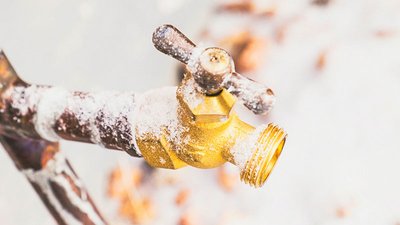Winter's coming: 6 top tips to prevent frozen pipes

With the colder months upon us, the maintenance of plumbing and heating systems once again becomes a priority for many homeowners, and installers need to be prepared for a rise in the number of callouts.
As temperatures fall and systems are subject to more regular usage, homeowners may notice problems arise. Whether its pipes becoming more prone to freezing, or problems with boilers as they go on for the first time in months, installers play a critical role in resolving these challenges and helping to keep homes warm and comfortable throughout the winter.
To tackle these common winter plumbing problems, there are several things professional plumbers can do in preparation. In this blog, we are going to take a look at six tips for preventing frozen pipes this winter and beyond.
1. The 6 Ps to prevent frozen pipes
One of the most common winter issues is frozen pipes. However, despite being common, this is a problem that can cause significant damage and impact the performance of hot water and central heating systems when they are needed most.
The best way to prevent frozen pipes is by future-proofing systems at the point of installation – or when maintenance is being carried out. Installers should therefore keep in mind the following ‘6 Ps’:
- Preparation: Go the extra mile before the winter arrives, adding protection to systems – such as insulating pipes or installing isolation valves - to help prevent problems and support maintenance.
- Pressure: The more pipework that freezes, the higher the internal pressure. It’s critical to solve this problem early, before problems grow.
- Placement: When running pipes, think about how exposed they will be to cold weather. External pipework will be more prone to freezing, but inside the home, try to keep pipes away from cold exterior walls, lofts or garages.
- Protection: If pipes are installed in areas more prone to cold, equip them with some protection in the form of insulation.
- Prevention: Besides considering pipe layout and protection, installers can also drain the pipes before bad weather sets in.
- Programming: Pipes can also be prevented from freezing by ensuring internal temperatures never drop too low. Simply programme the thermostat to keep temperatures stable.

2. Preventing MPDE pipes from freezing
Frozen pipes inside the home are one of the more damaging plumbing problems that can arise during the winter period. However, external plumbing such as MDPE pipes can be just as troublesome if affected by the colder temperatures.
Locating and solving this issue can be a major hassle, so taking a preventative approach to frozen pipes can help to ensure that it doesn’t happen in the first place.
To use soil as the main insulator, best practice is to ensure MDPE pipes are at least 600mm (2ft) deep. This is because when they are buried deep, the soil is able to hold onto the heat that it will collect from the sun during the day. If the pipe burial is 600mm, there is a lower chance that the pipes will freeze or become damaged, and it also prevents water freezing.
3. Add anti-freeze when installing underfloor heating during winter
Developing a new build property’s plumbing and heating system can often take multiple weeks or even months. Therefore, it’s not uncommon that underfloor heating (UFH) pipework is installed and screed is laid months before the property is ready for use.
If UFH pipework in the screed is subject to sub-zero conditions while the rest of the housing project is being completed, the water in the pipes can freeze. This runs the risk of the pipework weakening and splitting as the water expands upon freezing. And this problem may not happen or be detected until much later when the floor covering is installed, which could result in excess remedial work.
Adding antifreeze to the water in the pipework if there is potential for the UFH system to be exposed to freezing temperatures can prevent frozen pipes. Once the winter has passed, the water can be flushed out of the system and replaced.
4. Preparing for boiler checks and updated regulations
Whilst some homeowners are switching to more modern heat sources, such as heat pumps, the majority of homes still use a traditional gas boiler. Installers should be prepared to conduct more boiler services over the winter period and in the months preceding, as annual boiler maintenance is crucial to keeping these systems operating successfully.
This year, however, things look a little different, as updates to part L of the Building Regulations have changed how new boilers should be specified.
Sizing is a critical factor, with evidence of correct system sizing required to be provided to the customer. Additionally, exposed internal plumbing must be insulated prior to the installation of new appliances, and the maximum flow temperature shouldn’t exceed 55°C.

5. Knowing how to keep water heaters in check
Just as demand for boiler maintenance and servicing will increase during the winter, so will the need to maintain water heaters.
Ensuring that a water heater’s pressure relief valve is working properly is essential for effective and reliable performance. A pressure relief valve ensures that the water heater doesn’t get overworked, discharging excess water from the system to reduce the pressure of the water coming out of the outlet.
The 101 series Sealed Heating System Pressure Relief Valve from Reliance Valves is a great choice for when these valves need replacing.
6. Giving your customers best practice advice
Alongside the practical steps installers can take in their everyday work, they can also share best practice advice with their customers. As well as streamlining winter preparation, this approach enables homeowners themselves to take control of certain aspects of system maintenance.
One top tip to prevent frozen pipes is to disconnect outdoor plumbing from the water supply – an easy step to protect part of the system that is more prone to freezing.
Standard practice is to turn the isolation valve connected to the outdoor plumbing and remove any hoses or sprinklers that can be stored away for the winter. Furthermore, any outside taps should then be opened to allow water to drain out of them, as this stagnant water can increase the risk of the pipe freezing.

Manage your workflow
Winter is a busy time of year for installers, and with the low temperatures comes an influx of jobs. While this can make it a fruitful time of year from a business perspective, it increases the need for strong organisation and planning.
By planning ahead and scheduling jobs effectively, installers can ensure that their workloads are manageable. Of course, with the volume of emergency callouts likely to rise during this period, it is also advisable to allow for some flexible time in the schedule to accommodate last-minute requests and emergency jobs.
Need advice?
Whether you need technical support, product advice or help with your account, our teams are here to help and would love to hear from you.
